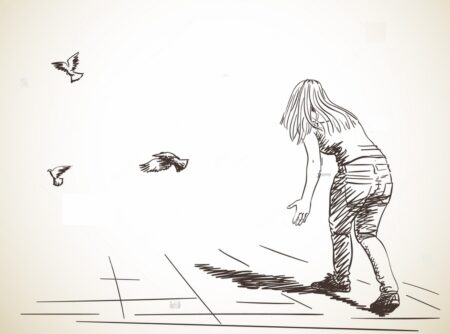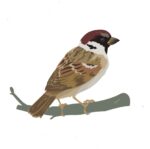How To Catch A Bird: Simple Guide
Catching a bird can be a challenging and delicate task, whether it is for scientific research, animal rescue, or as a pet. It requires patience, skill, and knowledge of bird behavior and anatomy. There are various techniques and tools that can be used to catch a bird, but it is important to approach the process with care and consideration for the bird’s well-being. This article gives some simple steps on how to catch a bird. Read along!
How To Catch A Bird: Simple Guide
Catching a bird can be a fun and exciting experience, but it requires patience, strategy, and a bit of luck. Here are some detailed steps on how to catch a bird.
- Choose the right location: The first step to catching a bird is to choose the right location. Birds can be found in various places such as parks, gardens, and forests. Find an area where you have seen a lot of bird activity, as this will increase your chances of catching one.
- Gather your supplies: To catch a bird, you’ll need some basic supplies such as a hat or net, a towel or cloth, a small box or cage, and some bird food. Make sure you have these items ready before you attempt to catch a bird.
- Practice patience: Catching a bird requires a lot of patience. You may need to wait for hours to spot a bird and make your move. It’s important to stay calm and still while you wait, so you don’t scare away the bird.
- Use bait: Birds are attracted to food, so using bait can be an effective way to catch them. Scatter some bird food or seeds near where you are waiting and be patient. The bird will eventually come closer to investigate the food, giving you an opportunity to catch it.
- Create a distraction: Another way to catch a bird is to create a distraction. This can be done by making a noise, such as tapping on a nearby tree or rustling some leaves. The sound will draw the bird’s attention, giving you a chance to catch it.
- Wear appropriate clothing: When attempting to catch a bird, it’s important to wear appropriate clothing. Avoid wearing bright colors and opt for neutral tones that will blend in with the environment. This will make it less likely for the bird to be startled by your presence.
- Be gentle: When you spot a bird and make your move, be gentle and move slowly. Sudden movements can startle the bird and cause it to fly away. Use a calm and quiet approach while trying to catch the bird.
- Use a net or hat: One effective way to catch a bird is by using a net or hat. When the bird is near you, carefully move the net or hat over it and gently trap it. Be careful not to harm the bird in the process.
- Wrap in a towel or cloth: If you don’t have a net or hat, you can also catch a bird by wrapping it in a towel or cloth. Slowly place the towel over the bird and gently wrap it up. This will minimize the chances of the bird flapping its wings and escaping.
- Transport the bird: Once you have caught the bird, carefully transfer it into a small box or cage. Make sure the container is well-ventilated and has enough space for the bird to move around. If possible, place some food and water in the container for the bird.
Remember to handle the bird gently and release it back into the wild as soon as possible. Catching a bird can be a thrilling experience, but it’s important to do so ethically and with the well-being of the bird in mind.
SEE ALSO: Are Birds Predators?
How to Catch A Bird Simple Guide With A Trap
Catching a bird can be tricky, but it is possible with the right equipment and technique. One way to catch a bird is by using a trap. Here is a simple guide on how to catch a bird with a trap.
Materials:
- A bird trap (can be purchased online or in a pet store)
- A bait (bird seed, fruit, or insects)
- A sturdy stick or pole
- Gloves (if handling a wild bird)
Step 1: Choose the right location: The first step is to choose a location that is frequented by the type of bird you are trying to catch. This could be in your backyard or a local park. It is important to make sure that the area is safe and free from predators.
Step 2: Set up the trap: Follow the instructions that came with your bird trap to set it up properly. In general, the trap will have a form of bait, such as a platform or wire, that can be activated once the bird steps on it. Make sure the trap is securely anchored to the ground.
Step 3: Set the bait: Place the bait on the designated spot on the trap. The type of bait you use will depend on the type of bird you are trying to catch. You can use bird seeds, fruits, or insects. It is best to use a bait that the bird is familiar with and is commonly found in its natural environment.
Step 4: Camouflage the trap: To make the trap less noticeable to the bird, you can camouflage it with leaves and twigs. This will make the trap blend in with the surroundings and make the bird feel more comfortable to approach it.
Step 5: Use a decoy: You can attract birds to the trap by using a decoy. This can be a fake bird or a recording of bird calls. Place the decoy near the trap to make it more enticing for the bird to approach.
Step 6: Wait and monitor: It may take some time for a bird to approach the trap, so be patient and keep an eye on it. You can also set up a camera to monitor the trap. Once the bird is caught, approach the trap slowly and calmly to avoid startling the bird.
Step 7: Release the bird: If you are catching a wild bird, it is important to handle it with care and wear gloves to protect yourself from any potential bites or scratches. Gently remove the bird from the trap and release it back into its natural habitat.
If you are catching a bird for a pet, make sure to provide a comfortable and safe environment for it to live in. Before releasing it, make sure to consult with a veterinarian or wildlife expert on the proper care and diet for the specific type of bird.
Remember, it is important to check your local laws and regulations before attempting to catch a bird. Some birds may be protected species and it is illegal to trap or keep them as pets.
How to Catch A Bird At Home
- Create a bait: The first step is to entice the bird with something they will want to eat. This could be bread crumbs, seeds, fruit, or insects. Place the bait in a bowl or on a flat surface near the area where you have spotted the bird.
- Use a box or net: Get a cardboard box or a long-handled net to help you catch the bird. The box should be big enough to fit the bird comfortably.
- Make sure the room is dark and quiet: Birds are easily startled by sudden movements and loud noises. Close the curtains or blinds to make the room darker and reduce outside noise.
- Slowly approach the bird: Move slowly and quietly towards the bird. If you have a net, slowly lower it over the bird from above. If you are using a box, place it gently over the bird.
- Confine the bird: Once you have captured the bird in the net or box, cover it with a towel or cloth to calm it down. This will also prevent it from flying away.
- Tame the bird: If the bird is a pet, you can use a towel to gently wrap it and hold it securely. Be careful not to squeeze or harm the bird.
How to Catch A Bird With Your Bare Hands
Catching a bird with your bare hands can be challenging, but with the right approach and technique, it is possible. Here are some steps you can follow to catch a bird with your bare hands:
- Approach the bird calmly and slowly: Birds have a natural fear of humans and will fly away if you rush towards them. To increase your chances of catching the bird, approach it calmly and slowly. Move in a crouched position, keeping your body low to the ground.
- Use visual barriers: If you’re trying to catch a bird in an open space, it is a good idea to use visual barriers to block its escape route. This can be anything from a large piece of cloth to a jacket or a hat. Hold the barrier between you and the bird to make it think it is cornered.
- Move your hands slowly: As you get closer to the bird, move your hands towards it slowly. Birds have excellent eyesight and can detect even the slightest movement. If you move too quickly, the bird will fly away.
- Use your hands to create a barrier: Once you are close enough to the bird, you can try to use your hands to create a barrier around it. This will prevent the bird from flying away while you try to catch it. Be careful not to touch the bird with your hands just yet.
- Use a distraction: You can also use a distraction to catch the bird. This could be anything from a piece of food to a twig or a leaf. Throw the distraction in another direction to divert the bird’s attention, then quickly use your hands to catch it.
- Move slowly and be patient: Patience is key when trying to catch a bird with your bare hands. Birds are naturally skittish and can take time to trust a human. Move slowly and give the bird time to get used to your presence before attempting to catch it.
- Catch the bird gently: When you are close enough to the bird, quickly cup your hands around it and lift it up gently. Be careful not to squeeze too tightly, as you could harm the bird. If the bird struggles, try to hold it firmly but gently until it calms down.
- Release the bird carefully: Once you have caught the bird, do not keep it for longer than necessary. If it is a wild bird, it may become stressed if kept in captivity. Release the bird in a safe and open area away from any predators.
Remember, catching a bird with your bare hands should only be done if absolutely necessary. It is always best to let birds be in their natural habitat. If you find an injured bird, it is advisable to contact a local wildlife rehabilitation center for assistance.
3 Easy Bird Trap
- Funnel Trap: This trap uses a funnel structure made with wire mesh to lure the bird inside. Once the bird is inside, it becomes trapped as the funnel gets narrower towards the end.
- Baited Snare Trap: This trap involves tying a bait, such as insects or seeds, to a string or fishing line. When the bird tries to eat the bait, it becomes entangled in the snare and is trapped.
- Cage Trap: This is one of the most common and easiest bird traps. It consists of a wire mesh cage with a trap door that can be triggered to close when the bird enters to eat the bait placed inside. The trap can then be retrieved with the bird inside.
SEE ALSO: Do Owls Eat Birds?
FAQs
Q. What is the best bait for birds?
A. The best bait for birds depends on the type of bird you are trying to attract. Generally, seeds such as sunflower seeds, millet, and safflower are popular choices.
Q. How do you catch a bird on the ground?
A. To catch a bird on the ground, you can try using a net or a blanket to gently cover and secure the bird. You can also lure the bird with food and then quickly cup it in your hands.
Q. How do you catch a bird with a sheet?
A. To catch a bird with a sheet, you should start by placing the sheet on the ground, and holding it by the edges. Slowly approach the bird, using the sheet to cover it from above. As the bird is trying to escape, carefully wrap the sheet around it, making sure not to injure it. Once the bird is secure in the sheet, gently lift it up and hold it firmly. Make sure to handle the bird with care and release it back into its natural habitat as soon as possible.
Q. What is the easiest way to catch a bird?
A. The easiest way to catch a bird is to use a bird feeder or birdseed to attract the bird close enough to be caught by hand or with a net. Alternatively, setting up a trap or using a bird call to lure the bird into a specific location can also make catching easier.
Conclusion
Catching a bird requires patience, observation, and the use of proper techniques. It is important to understand the behavior of birds and to choose the right tools and methods for catching them. It is also important to prioritize the safety and well-being of the birds and handle them with care. Remember to always release the bird back into its habitat after capturing it. If you are not confident in your ability to catch a bird, it is best to leave it to trained professionals. Overall, catching a bird can be a rewarding experience when done responsibly and ethically.


